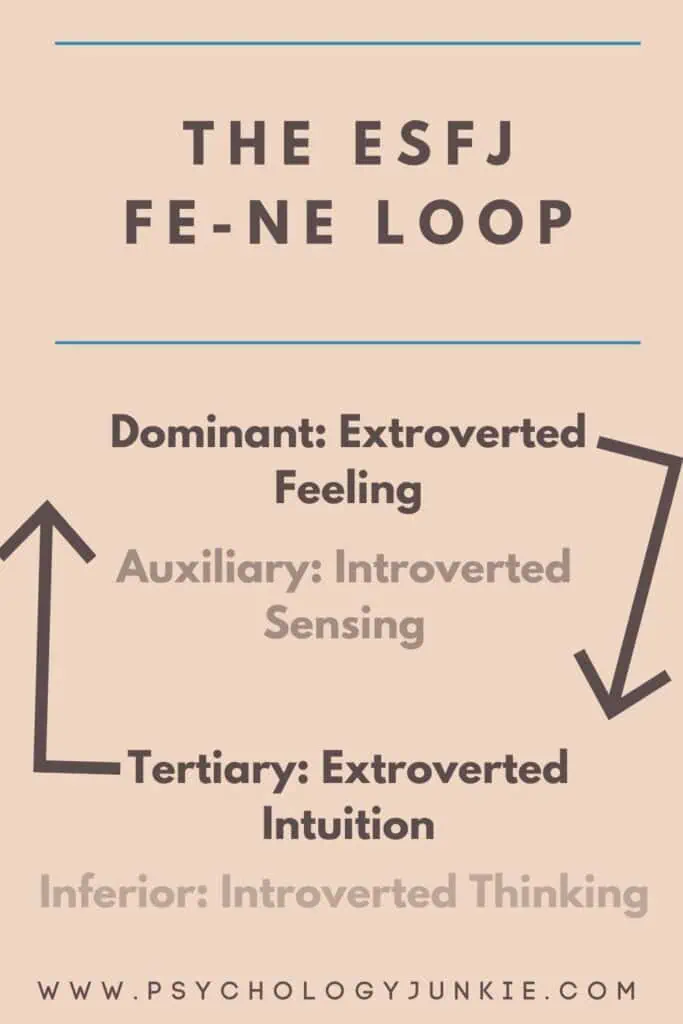The ESFJ Loop (Fe-Ne): What It Is and How to Cope
Do you ever find yourself bouncing from one idea to the next, desperately trying to keep the excitement alive, only to feel like you’re spinning your wheels? As an ESFJ, you’re a natural at creating group cohesion, knowing what people need, and creating a sense of community. But sometimes, even your superpowers can take an unexpected detour. This happens when you get stuck in an Fe-Ne loop—where your dominant Extraverted Feeling (Fe) and tertiary Extraverted Intuition (Ne) run the show, while the more grounding Introverted Sensing (Si) takes a really long nap.
Not sure what your personality type is? You can check out our in-depth personality questionnaire here.

But What Are Fe and Ne Anyway?
Before we dive into the loop, let’s clarify what a cognitive function stack is. Think of it as a mental toolbox you rely on to navigate life. ESFJs have a unique set of tools: Extraverted Feeling (Fe), Introverted Sensing (Si), Extraverted Intuition (Ne), and Introverted Thinking (Ti).
Imagine these functions as tools on your workbench. Fe and Si are the heavy lifters, used all the time. Ne and Ti, on the other hand, are like those tools you only reach for occasionally (and usually with a hint of skepticism). But when you get stuck in an Fe-Ne loop, it’s like you’re trying to solve every problem using only Fe and Ne, while Si and Ti gather dust.
A Deeper Look at the ESFJ’s Cognitive Functions
Here’s a quick breakdown of your cognitive toolkit:
- Extraverted Feeling (Fe): Your dominant function. Fe is all about connecting with others, understanding their emotions, and maintaining harmony. It’s why people love having you around at social gatherings—you’re a natural at reading the room and making everyone feel comfortable.
- Introverted Sensing (Si): Your auxiliary function, Si, helps you stay grounded by relying on past experiences and details. It’s the function that remembers important dates, notices when things are out of place, and keeps life running smoothly.
- Extraverted Intuition (Ne): Your tertiary function, Ne, opens your mind to new possibilities and ideas. It’s what gives you that occasional spark of creativity and curiosity, pushing you to explore new hobbies or entertain different perspectives.
- Introverted Thinking (Ti): Your least-used function, Ti, is about analyzing things objectively. It’s not your go-to tool, but it can come in handy when you need to make sense of the details.
What Happens in a Fe-Ne Loop?
Just like our cute capybara friend up there, ESFJs can feel a bit scattered and overwhelmed when they’re in a loop. Kind of like they can’t access their own individual thoughts. They start cycling between their dominant Fe and tertiary Ne, without bringing in the stabilizing influence of Si or the objectivity of Ti. In this loop, you become more focused on social dynamics and possibilities, often at the expense of practical considerations. It’s as if you’re constantly chasing novelty and interaction, jumping from one idea or conversation to the next without pausing to analyze deeply.
How Does the Fe-Ne Loop Show Up in Everyday Life?
When you’re stuck in this loop, your usual grounded, supportive self takes a backseat. You might find yourself:
- Jumping to conclusions too quickly, convinced you know exactly how others feel or what’s going to happen next.
- Chasing new experiences to distract yourself from feelings of insecurity or discontentment, hopping from one project or social event to the next.
- Creating drama just to keep things interesting (admit it—you love a good story, even if it’s at your own expense).
- Projecting blame onto others when things don’t go as planned, instead of taking a step back to assess the situation.
- Manipulating information to fit the narrative you’ve already decided on.
- Imagining worst-case scenarios, and immediately feeling you must prevent them in an erratic fashion.
- Forming suspicions and reading into people’s actions and behaviors, convinced there’s an ulterior motive or “pattern” behind it.
- Repeating the same mistakes without learning from them, because you’re so caught up in the excitement of trying something new.
Why Does the Fe-Ne Loop Happen?
We all have comfort zones. For you, that comfort zone is interacting with the world around you, making connections, and exploring possibilities. In short, your comfort zone is the extroverted world. Fe and Ne are both extroverted functions, so they draw you outside yourself. While that can feel thrilling, it can also make you lose touch with your inner sense of consistency and reality.
When you’re relying solely on your extraverted functions, it’s easy to get swept up in excitement or a rush of ideas without stopping to reflect or assess. Even as an ESFJ you still have an introverted side; nobody is a pure introvert or extrovert. When you ignore any particular side of yourself for too long, looping happens.
How Do ESFJs Feel When They’re in a Loop?
Picture this: You’re bouncing from one social event to the next, filled with excitement and new ideas. But somewhere along the line, you start to feel ungrounded—like you’re doing a lot but not really accomplishing anything meaningful. You’re overstimulated, drained, and maybe even a little lost.
Or another example? You’re a busy person. Your job is demanding, you’re also planning your child’s birthday party, and making lots of phone calls with your wide group of friends. In the midst of all the busyness, you start to feel like your life is spiraling out of control. You start to imagine worst-case scenario possibilities (the party will be a flop, you can’t focus on details at work so you’ll get fired, your friend is conspiring against you). Instead of checking the facts, reflecting on the logic, and really assessing the situation thoroughly, you jump to a conclusion. You start to see patterns everywhere that prove your assumptions are correct. That’s another example of the Fe-Ne loop.
I once knew an ESFJ who formed a whole group of friends that united around conspiracy theories and gossip. She had her close-knit buddies, but they were quick to believe negative things about other people and would often share bizarre news stories with each other, convinced that they were accurate without checking the sources or reading opposing arguments. This ESFJ was in a long-term loop, but over time, and with some counseling, started to realize that she needed to get in touch with her inner pragmatic sensing side along with a healthy dose of logical skepticism. Over time she started to realize that her friend group was feeding each other on suspicion, paranoia, and gossip, and it wasn’t doing her or anyone else any favors.
Now I’m not saying having one or two conspiracy theories is a bad thing (I think we should all have at least one!). But if you start to see worst-case scenarios and conspiracies all around you, you might just want to do some fact checking and skeptical analysis before buying into it fully.
So let’s sum it up…
Signs You’re Stuck in an Fe-Ne Loop:
- You’re constantly seeking social stimulation or novelty but end up feeling more drained than fulfilled.
- You make quick judgments or assumptions without gathering enough information.
- You struggle to focus on practical tasks or responsibilities.
- You feel ungrounded and disconnected from your usual sense of stability.
- You notice a pattern of repeating the same mistakes or engaging in risky behavior without learning from it.
- You feel suspicious of people and see negative patterns everywhere.
How to Get Out of an Fe-Ne Loop
The solution? It’s time to bring your Introverted Sensing (Si) back into the picture. Si helps you slow down, reflect, and focus on the familiar. Here’s how to reconnect with it:
- Embrace Routine: Get back to the activities that make you feel grounded. Whether it’s cooking your favorite comfort food, organizing your space, or revisiting an old hobby, familiar routines can help anchor you.
- Reflect on the Past: Take time to review what’s worked for you before and what hasn’t. This isn’t about dwelling on past mistakes but learning from them. Use your rich memory bank to guide your decisions.
- Analyze the Facts: Before jumping to conclusions or making a big decision, take a step back and assess the situation logically. Look at the history and details before moving forward.
- Set Practical Goals: Instead of chasing every new idea or social opportunity, focus on a few concrete, achievable goals. This will help you channel your energy into something meaningful.
- Make Time For Mindfulness. Instead of talking on the phone or texting every time there’s a spare moment, really absorb the details of the moment you’re in. Truly savor a morning sunset or the nuanced flavors of your evening meal. Meditate and quiet your mind. Look for beauty in the small details like clover growing in the yard, the smell of fall leaves, or the warmth and comfort of a soft blanket. Quiet your mind and let yourself be fully present.
Real-Life Example: I once worked with an ESFJ who was caught in an Fe-Ne loop, constantly searching for new ways to “find herself.” She kept picking up new hobbies, making impulsive social plans, and even considering a sudden career change. But all the excitement didn’t bring her any closer to clarity. Eventually, she started grounding herself with familiar routines—journaling, reconnecting with close friends, and sticking to a consistent daily schedule. Slowly but surely, she felt more centered and at peace.
What Are Your Thoughts?
Has this explanation of the Fe-Ne loop resonated with you? Share your experiences in the comments! Whether you’ve been stuck in a loop yourself or have tips for breaking free, I’d love to hear your insights. And keep in mind, we all experience these loops from time to time. It doesn’t make you a bad person! But knowing about these negative patterns can help us to course-correct, kind of like when you’re driving and you hear the rumble strip on the side of the road that alerts you when you’re going off course.
For more information on cognitive functions and how they work, check out our eBooks, including Discovering You: Unlocking the Power of Personality Type.
Other Articles You Might Enjoy:
10 Things ESFJs Need in a Relationship
24 Signs That You’re an ESFJ, the Defender Personality Type
References:
The Principles of Cognitive Function Theory
Personality Hacker: Harness the power of your personality type to transform your work, relationships and life by Joel Mark Witt and Antonia Dodge (Ulysses Press, 2018)












